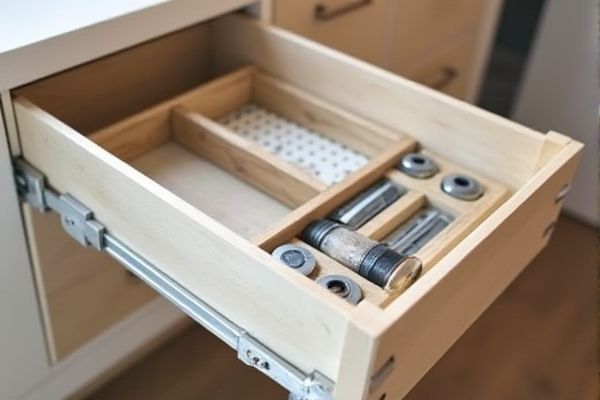
Drawer dividers maximize organization by creating customizable compartments within your drawers, preventing clutter and making it easier to locate items quickly. Shelf dividers, on the other hand, separate vertical space on shelves to keep stacks neat and prevent items from toppling over, enhancing overall storage efficiency; explore the differences to find the best solution for your storage needs in the rest of this article.
Table of Comparison
| Feature | Drawer Dividers | Shelf Dividers |
|---|---|---|
| Purpose | Organize items within drawers | Separate and organize items on shelves |
| Common Materials | Plastic, wood, metal | Metal, wood, acrylic |
| Adjustability | Often adjustable or customizable | Fixed or adjustable options available |
| Installation | Simple, fits inside drawers | May require mounting or placing upright on shelves |
| Use Cases | Cutlery, office supplies, clothing | Books, files, kitchenware |
| Space Optimization | Maximizes drawer space and prevents clutter | Keeps items vertical and organized on shelves |
| Customization | Modular designs allow tailored fits | Available in various heights and widths |
| Cost | Generally low to moderate | Varies depending on materials and size |
Introduction to Drawer Dividers and Shelf Dividers
Drawer dividers and shelf dividers are essential organizational tools designed to maximize space efficiency in cabinets and drawers. Drawer dividers segment the interior compartment to keep items neatly separated and easily accessible, while shelf dividers create vertical partitions on flat surfaces to prevent stacking clutter. Your storage system benefits from choosing the right type based on the specific area and items you need to organize.
Functionality Differences: Drawers vs. Shelves
Drawer dividers maximize organization by creating customized compartments within enclosed spaces, preventing items from shifting during movement. Shelf dividers, on the other hand, maintain order by separating vertical spaces, allowing easy access and visibility of stored items. Your choice depends on whether you need compartmentalized storage in confined areas or clear segmentation on open shelving.
Material and Design Options
Drawer dividers are commonly made from materials like bamboo, plastic, and metal, offering flexible, adjustable designs that fit various drawer sizes and shapes. Shelf dividers often use sturdy materials such as metal, acrylic, or wood to maintain upright separation on open shelving, with designs that emphasize vertical partitioning to optimize storage space. Both types of dividers come in customizable options, allowing users to select materials and styles that complement home decor and storage needs.
Space Optimization: Which Divider Wins?
Drawer dividers maximize space by creating customizable, segmented compartments that keep smaller items organized and easily accessible, preventing clutter within confined areas. Shelf dividers optimize vertical storage, enabling you to separate stacks and layers, making the most of unused height without wasting shelf surface. Your choice depends on the type of storage you need to optimize: drawer dividers excel in compact, contained spaces, while shelf dividers shine in open, vertical areas.
Installation and Ease of Use
Drawer dividers typically offer simple installation, often snapping into place or fitting snugly without tools, making them highly convenient for quick organization. Shelf dividers may require more effort, such as using brackets or adhesive, which can involve tools and careful measurement to ensure stability. Users often find drawer dividers easier to adjust and reposition, enhancing versatility in managing smaller items compared to the more fixed nature of shelf dividers.
Best Uses for Drawer Dividers
Drawer dividers are ideal for organizing smaller items such as utensils, office supplies, or makeup, providing segmented storage that maximizes space efficiency. They help maintain order by preventing items from shifting and mixing, which is particularly beneficial in kitchen drawers, desk drawers, and vanity drawers. Their customizable sizes and materials allow for tailored organization solutions that fit various drawer dimensions and user needs.
Best Uses for Shelf Dividers
Shelf dividers organize larger storage areas by separating items like clothing stacks, books, or kitchenware, preventing mess and maximizing vertical space. Their best uses include closets for sorting sweaters and pants, pantries to keep canned goods upright and categorized, and bookshelves to maintain neat rows of literature. By incorporating shelf dividers, you maintain clear visibility of your belongings, streamline access, and enhance overall storage efficiency.
Durability and Maintenance Comparison
Drawer dividers typically offer higher durability due to their compact design and use of sturdy materials like wood or metal, resisting wear from frequent opening and closing. Shelf dividers, often made from acrylic or plastic, may require more frequent cleaning to prevent dust and fingerprints, potentially impacting their long-term appearance. Maintenance for drawer dividers generally involves occasional wiping and checking for alignment, while shelf dividers demand regular dusting and careful handling to avoid scratches.
Cost and Value Considerations
Drawer dividers generally offer a lower upfront cost compared to shelf dividers, making them a budget-friendly option for organizing smaller spaces. Shelf dividers, while often pricier, provide greater versatility and long-term value by maximizing vertical space and improving overall storage efficiency. Your choice should balance initial investment with the organizational benefits tailored to your specific storage needs.
Choosing the Right Divider for Your Space
Drawer dividers offer customizable organization by fitting snugly inside drawers, ideal for separating smaller items like utensils or accessories. Shelf dividers create vertical barriers on open shelves, perfect for categorizing larger items or preventing stacks from toppling. Understanding your storage needs and space layout will help you select the right divider, optimizing both accessibility and tidiness.
 homyna.com
homyna.com